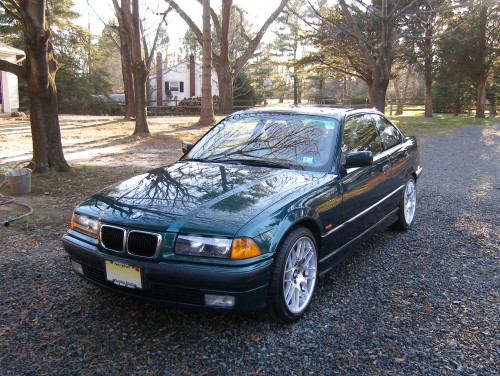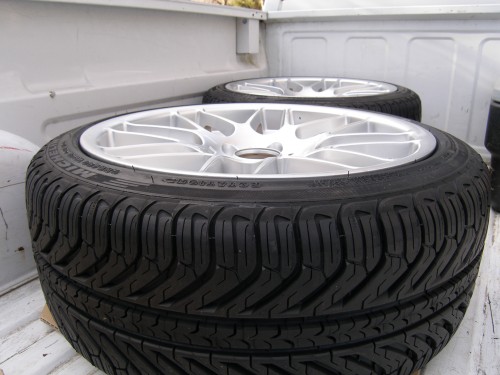December 10, 2006
CSL Replica Wheels and Tires Installed
 The Pilot Sport A/S tires showed up at my dealer on Thursday and I arranged
to have my tech mount & balance them Friday. I threw the wheel boxes in
the back of the pickup truck and took them to the dealership before work. As
I transferred the boxes to my technician's bay, he commented on the utility
of a pickup truck in such situations. With a straight face I replied "yea,
this truck is awesome...it goes 0 to 60 in FOREVER. The only problem is if
I drive it for more than 30 minutes at a time, I lose the ability to do complex
math!" He chuckled as I broke into a smile.
The Pilot Sport A/S tires showed up at my dealer on Thursday and I arranged
to have my tech mount & balance them Friday. I threw the wheel boxes in
the back of the pickup truck and took them to the dealership before work. As
I transferred the boxes to my technician's bay, he commented on the utility
of a pickup truck in such situations. With a straight face I replied "yea,
this truck is awesome...it goes 0 to 60 in FOREVER. The only problem is if
I drive it for more than 30 minutes at a time, I lose the ability to do complex
math!" He chuckled as I broke into a smile.
While my technician finished the job later that day, I couldn't get away from work until later that night, so I figured I'd take advantage of my dealer's new Saturday hours to pick them up.
After a brief diversion to my county HazMat facility to drop off some old paint, household cleaners, a long-dead car battery and some used motor oil, I arrived at the dealership Saturday morning to find that my technician had stacked the wheels in one of the rear bays in the shop separated by pieces of cardboard as requested. As I carefully loaded them into the back of the pickup truck, a couple of techs wandered by. One guy commented that they looked good. I explained the fact that while they're replicas made in the far east and lack the casting quality and finish of the OE wheels when viewed up close, they admittedly look good at typical viewing distances, get the job done, and are about one-third the price of OE wheels (that is, assuming, you wanted to put up with 19" wheels, as there is no such thing as a 18" CSL / competition package wheel).
Upon closer inspection, I found my technician had to use anywhere from 0.5oz to 1.5oz of weights to balance them. I'm not sure whether this was due to casting irregularities or tire issues, but he was able to balance them with a minimum of weight by placing the weights on the outside edge of the wheel. It's certainly possible to put weights inside the face of the wheel where they are less noticeable, but weights are most effective when placed on the outside edge. This isn't a particularly attractive option, but I asked my technician to use his best judgement. My opinion is that looks take a back seat to function when necessary, and that's particularly true in the case of wheel weights since I can't see the weights when I'm driving (and truth be told, no one else can either).
A couple of hours later, I managed to install the wheels. They went on the car easily enough, and I noticed the hubcentric design fit the hubs snugly. This is important because a close fit in this area is required to prevent vibration or other problems that detract from the driving experience.
The Drive
So how's it drive? In a word: great. I was very concerned about how low-profile tires would affect the vehicle's well-balanced stock handling characteristics because this car is my daily driver. While I like the E46's ZHP suspension and it's a blast to drive fast in the twisties, I can honestly tell you that I do find it fatiguing to drive for a number of reasons and I did NOT want to recreate that feel with the E36. On the test drive, I was relieved to find that the car drove like it did running on the 16" wheels with a few minor exceptions.
First of all, I do feel more defects in the road through the steering wheel (front tires) and the "seat of my pants" (rear tires). This is to be expected with a shorter and stiffer sidewall. The tires are simply communicating more of those defects to the wheels, which are then transmitted through suspension components to the body structure. The ride is still perfectly smooth and is not jarring in any sense like the ZHP can be under certain conditions.
The turn-in is radically improved, as one would expect from larger wheels to spread the load, slightly wider tires, and a stiffer sidewall. The tires don't have as much "give" and when commanded to turn, they turn. I haven't yet explored the limits of the tires because I need to let them break-in first, but if the first few turns are any indication, the wider tires and wheels on the front of the car will significantly reduce understeer and therefore increase turning performance.
The pleasant surprise was the noticeable lack of steering instability that occurred with the 16" Pilot Sport A/S. Let me explain what I mean. Long time readers will remember that the car came from the factory with a summer tire, the Dunlop SP2000. I replaced that with a similar high performance summer tire, the SP8000. While I've forgotten how the SP2000's drove (yes, it's been nine years -- give me a break) I do recall that the SP8000's tramlined badly. I didn't have enough experience with the BMW (and, admittedly, cars in general) at that time to recognize the condition as a function of tires, but it was one of the reasons why I ultimately chose to replace it with the Pilot Sport A/S in 16x7, 225/50 fitment.
The Pilot Sport A/S cured the tramlining problem and returned the classic BMW "neutral" steering feel. Unfortunately, at times I felt the steering to be almost "too neutral". Call it "loose". Based on my short-term experience with the new wheels and tires, I can now say that the gyroscopic effects of the larger wheel mass combined with a stout, stiff sidewall perfectly stabilize the steering in the neutral position and contribute to an overall sense of steering precision that the car simply lacked up to this point. In that sense it steers a bit more like the E46, but is actually far more comfortable to drive for long periods because of the lower-ratio steering rack. To put it another way, the E36 has a slight deadband around the neutral steering position. The E46 does not.
The one negative is that acceleration is reduced slightly, but that was expected. The car has to get a lot more mass moving and that mass is farther away from the center of the hub. It's a simple matter of physics. On the upside, the one "radical departure" I made did not spin the wheels, so ASC never cut in, and the result was a nice, smooth, fast departure. Larger wheels won't help the quarter mile times, but I don't really care about that. All I *do* care about is ride quality, minimizing understeer and increasing overall traction in the twisties, which is where this car shines...as is the case with most BMWs.
The Look
 How does it look? Amazingly good considering the
wheels were not designed specifically for the E36 body. They give the car a more
aggressive, yet classy, look. While the body designers recently enlisted by BMW
clearly need to see the business end of a .357, I have only praise for
the wheel designers. BMW's
wheel designs have become progressively more interesting and remained tasteful
and classy at the same time. I mean, does anyone remember what the E36 "bottle
caps" looked like? Egad. The sport-package double-spoke 16" wheels
were the best-looking wheels of the day and still look great on the car, but
it's safe to say the 18" CSL design tastefully advances the look of the
E36 and brings it into the current day.
How does it look? Amazingly good considering the
wheels were not designed specifically for the E36 body. They give the car a more
aggressive, yet classy, look. While the body designers recently enlisted by BMW
clearly need to see the business end of a .357, I have only praise for
the wheel designers. BMW's
wheel designs have become progressively more interesting and remained tasteful
and classy at the same time. I mean, does anyone remember what the E36 "bottle
caps" looked like? Egad. The sport-package double-spoke 16" wheels
were the best-looking wheels of the day and still look great on the car, but
it's safe to say the 18" CSL design tastefully advances the look of the
E36 and brings it into the current day.
So how's the stretch, you ask? Fine. I'm really happy that I chose to go with 235/40's on the 8.5" wheel. The protective ridge of the tire extends just beyond the rim of the wheel. It's not enough to protect the rim in the event I curb it, but then again, neither was the 255/35 on the rear of the E46. You just have to accept the fact that curbing these wheels costs money, and you need to do everything in your power to avoid doing so.
Brakes Inspection and Followup
This week I'd noticed that if I pressed lightly on the brakes as I slowed to a stop, one of the brakes would squeal. It was very faint and happened only once every 10 stops or so, but it was enough to convince me I should pull the calipers off and apply some additional Plastilube grease on the contact points between the pads and the carrier bracket. I did this at the same time as the wheel swap for obvious reasons.
I'll admit that I did not put a lot of Plastilube on the carrier brackets originally because my technician suggested that the job required very little grease in general, but after looking at the TIS (BMW service information), I realized I didn't coat some areas BMW recommends. With that new found knowledge, I added grease in the proper points and reassembled the brakes. Naturally, the calipers came off very easily this time because no ridge had yet formed on the rotors. In fact, it took me less than five minutes to complete the operation per wheel. I can now see why people find it easy to change pads at the track. If you're not taking off the carrier bracket, etc, R&R'ing the calipers really takes no time.
The downside? During the test drive with the new wheels, the brakes squealed again. Not sure what the problem is. It may just be a characteristic of the OE pads I received (they do reserve the right to change the formulation), but more likely there's just something I've done wrong, as I have NEVER heard the brakes squeal on this car. If I come up with a cause and solution you'll read it here, that's for sure.
Mileage: 136480, Labor: $217



